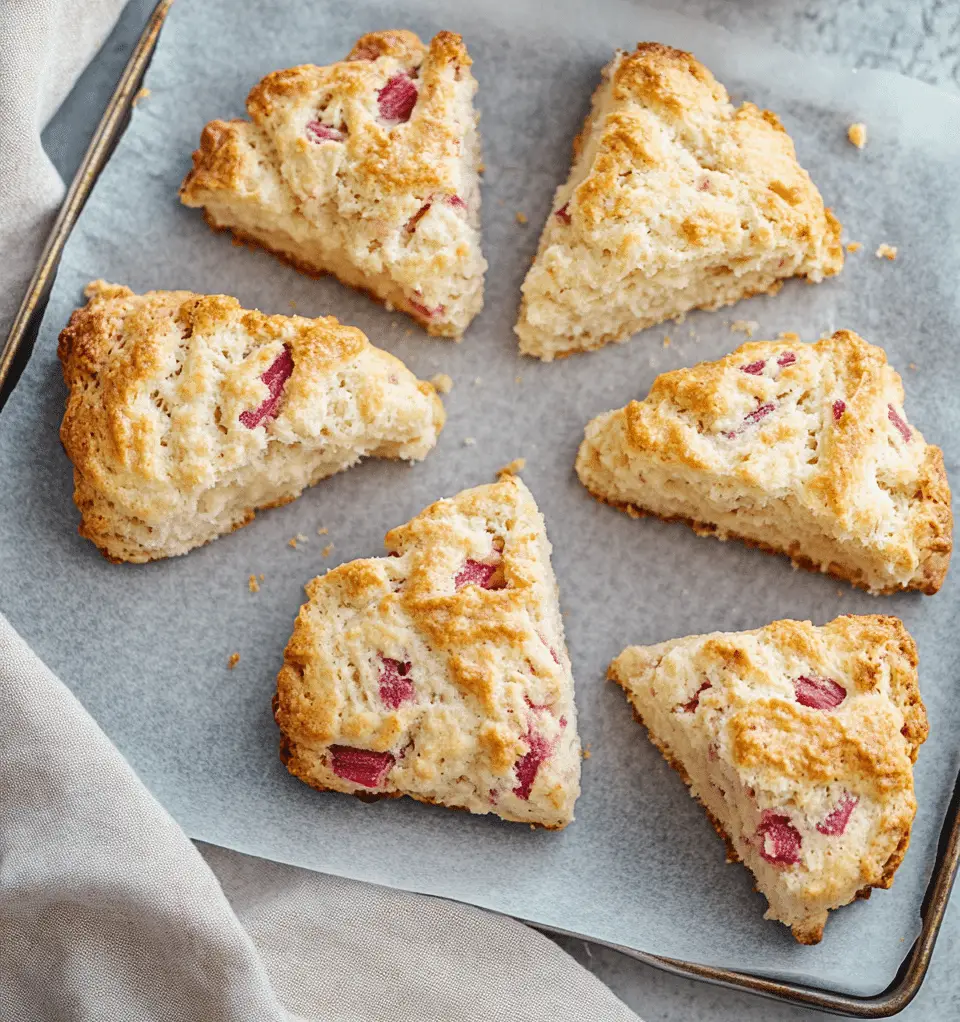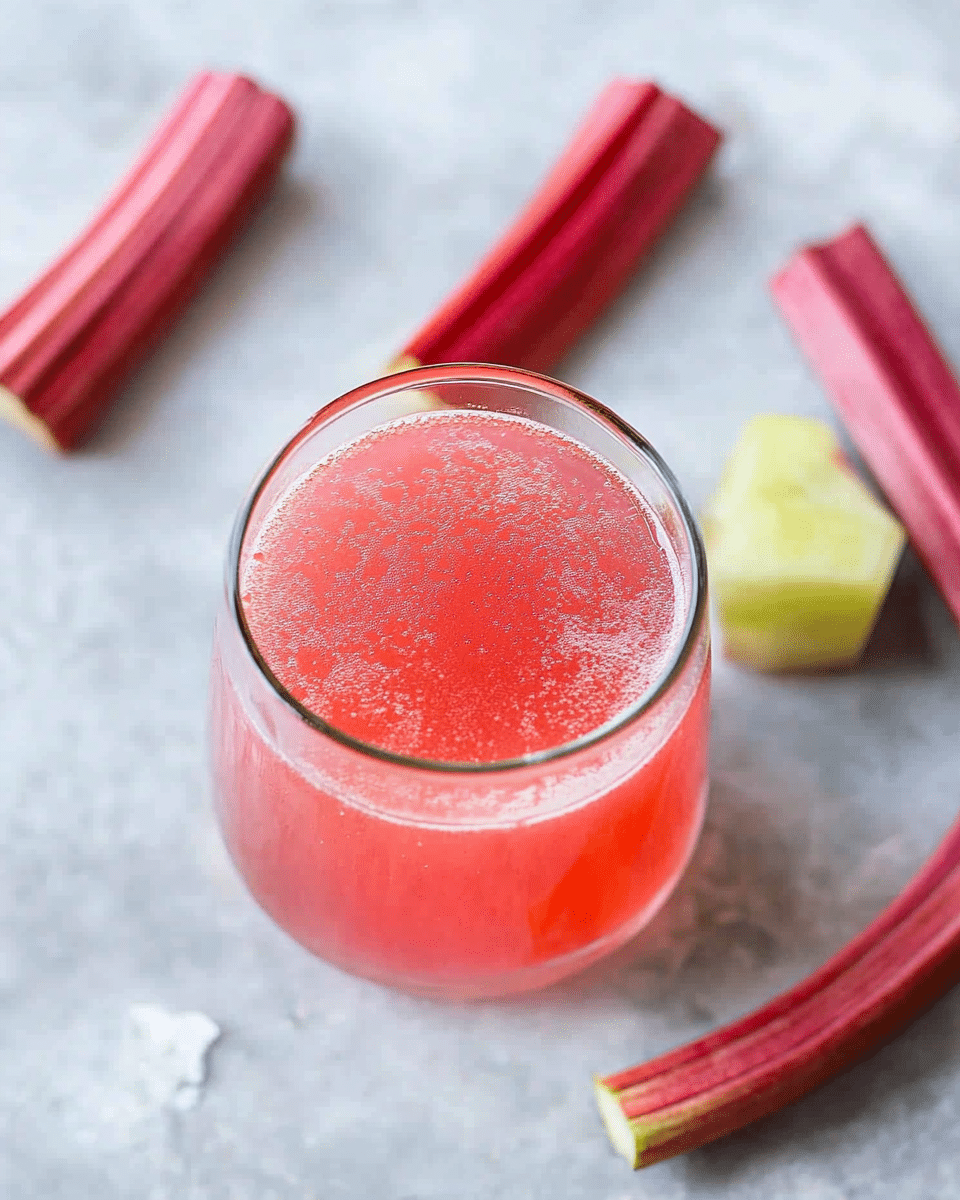A classic treat with a tender, buttery crumb and bursts of tart rhubarb, these scones bring a perfect balance of sweet and tangy. Grandma’s favorite recipe is ideal for breakfast or a cozy afternoon tea.
FULL RECIPE
Ingredients
- 2 cups all-purpose flour
- 1/4 cup granulated sugar
- 1 tablespoon baking powder
- 1/2 teaspoon salt
- 1/2 cup cold unsalted butter, cut into small pieces
- 1 cup fresh rhubarb, diced
- 2/3 cup heavy cream, plus extra for brushing
- 1 large egg
- 1 teaspoon vanilla extract
- Optional: coarse sugar for sprinkling
Directions
- Preheat the oven to 400°F (200°C). Line a baking sheet with parchment paper.
- In a large bowl, whisk together flour, sugar, baking powder, and salt.
- Cut in the cold butter with a pastry cutter or your fingers until the mixture resembles coarse crumbs.
- Gently fold in the diced rhubarb.
- In a separate bowl, whisk together heavy cream, egg, and vanilla extract.
- Pour the wet ingredients into the dry and stir just until combined; do not overmix.
- Turn the dough out onto a lightly floured surface and gently knead a few times to bring it together. Pat into a 1-inch thick round.
- Cut into 8 wedges and place them on the baking sheet. Brush the tops with cream and sprinkle with coarse sugar if desired.
- Bake for 18-22 minutes or until golden brown and a toothpick inserted comes out clean.
- Cool slightly before serving.
Nutritional Information
- Calories: 250 kcal
- Total Fat: 15g
- Saturated Fat: 9g
- Cholesterol: 55mg
- Sodium: 250mg
- Total Carbohydrates: 25g
- Dietary Fiber: 1g
- Sugars: 7g
- Protein: 4g
The History of Rhubarb Scones
Rhubarb has long been celebrated in traditional baking, especially in regions where it grows abundantly during spring and early summer. Rhubarb scones are a beloved adaptation of the classic British scone, incorporating the tartness of rhubarb to balance the richness of buttery dough. This combination reflects the age-old practice of blending fresh, seasonal fruits with simple pastries to create comforting and flavorful treats. Over time, these scones became a staple in many households, often passed down through generations, earning the affectionate title of “Grandma’s favorite.”
Why Use Rhubarb in Baking
Rhubarb offers a unique flavor profile — its tartness is unlike most fruits, making it a perfect counterpoint to sweet baked goods. Unlike sweeter fruits such as berries or apples, rhubarb brings a sharpness that enhances the overall taste without overpowering it. Its natural acidity also interacts beautifully with baking soda and powder, helping the dough to rise well and create a light texture. Additionally, rhubarb is low in calories and high in fiber, adding a nutritional bonus to indulgent pastries.
The Importance of Butter in Scones
Butter is the key ingredient that gives scones their tender, flaky texture and rich flavor. Using cold, unsalted butter ensures the dough forms small pockets of fat that melt during baking, creating the signature crumbly layers. The quality of the butter significantly influences the final taste and mouthfeel of the scones. In this recipe, the balance between butter and dry ingredients is carefully calibrated to avoid dryness, ensuring a moist and indulgent bite.
Choosing the Right Flour for Scones
All-purpose flour is commonly used in scone recipes because it provides the right balance of protein for structure and tenderness. Higher protein flours like bread flour would create tougher scones, while cake flour would be too soft and fragile. The flour’s gluten content helps the scones hold together while still allowing them to rise and become fluffy. For a slightly healthier twist, some bakers incorporate part whole wheat flour, but this can alter the texture and flavor.
The Role of Baking Powder and Leavening Agents
Baking powder is essential in scones for providing lift and lightness. It reacts with the moisture and heat to release carbon dioxide, which causes the dough to rise and expand. Without adequate leavening, scones would turn out dense and heavy. The amount used in this recipe strikes a perfect balance — enough to create fluffy, tender scones without leaving a bitter aftertaste. Properly measuring and evenly distributing the baking powder throughout the flour is crucial.
How to Handle the Dough for Best Texture
Overworking scone dough can lead to tough, dense baked goods. This recipe emphasizes gentle mixing and minimal kneading to preserve the butter pockets and ensure tender crumb. Handling the dough lightly prevents gluten overdevelopment, which would otherwise make the scones chewy instead of flaky. Pressing the dough into a round and cutting wedges maintains an even shape and promotes uniform baking.
The Benefits of Using Fresh Rhubarb
Fresh rhubarb provides the best texture and flavor in these scones. Its natural juiciness adds moisture and its vibrant color creates visual appeal. When fresh rhubarb is in season, the scones benefit from a bright, tangy flavor that canned or frozen rhubarb cannot match. Fresh rhubarb’s crispness also helps prevent the dough from becoming soggy during baking, resulting in a perfect balance of softness and structure.
Variations and Serving Suggestions
While this recipe is delicious on its own, there are many ways to customize rhubarb scones. Some people add a touch of cinnamon or ginger for warmth, or fold in white chocolate chips for sweetness that contrasts the tart rhubarb. These scones are excellent served warm with clotted cream, butter, or a drizzle of honey. They also pair wonderfully with a cup of tea or coffee, making them a versatile treat for breakfast, brunch, or afternoon snack.
Nutritional Aspects of Rhubarb Scones
Though indulgent, rhubarb scones contain nutritional benefits thanks to the fruit’s fiber and vitamin content. Rhubarb is rich in vitamin K and antioxidants, which contribute to bone health and reduce inflammation. However, because scones contain butter and sugar, moderation is key. Understanding the balance between enjoyment and nutrition helps bakers appreciate the scones as an occasional treat rather than an everyday snack.
Tips for Perfect Baking Results
Achieving golden, flaky scones every time involves attention to detail. Preheating the oven fully ensures even rising and browning. Using cold ingredients prevents the butter from melting too soon, which is critical for flakiness. Checking scones near the end of baking avoids overcooking, which can dry them out. Lastly, letting scones cool briefly before serving helps set their texture and prevents crumbling.
Storing and Reheating Rhubarb Scones
Scones are best enjoyed fresh but can be stored properly for later. They keep well at room temperature in an airtight container for 1-2 days. For longer storage, freezing is ideal; wrap each scone tightly and thaw before reheating. To refresh the texture, warm scones briefly in a toaster oven or microwave, which restores softness and flavor. Proper storage and reheating help maintain the scones’ quality without sacrificing taste.
The Cultural Significance of Scones in Baking
Scones hold a cherished place in British and Commonwealth culinary traditions, often associated with teatime rituals and family gatherings. Rhubarb scones add a regional twist to this classic, reflecting local ingredients and seasonal availability. The act of baking scones is often a communal experience, bringing people together in kitchens and around tables, creating memories alongside the delicious food.
Conclusion
Buttery Rhubarb Scones combine the nostalgic comfort of a classic scone with the bright, fresh flavor of rhubarb, creating a treat that is both timeless and uniquely satisfying. From the careful selection of ingredients to the gentle preparation methods, every step contributes to the perfect balance of texture and taste. Whether served for breakfast, afternoon tea, or a special occasion, these scones offer a delightful experience that honors tradition while embracing seasonal freshness. Their versatility and charm ensure they remain a favorite across generations, truly deserving the title of Grandma’s favorite.








